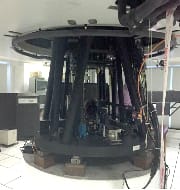Asia’s biggest telescope MAST inaugurated at Udaipur Solar Observatory in Rajasthan
Multi-Application Solar Telescope (MAST), Asia’s biggest telescope was inaugurated at the Udaipur Solar Observatory in Rajasthan.
It was inaugurated by Professor U.R Rao, Chairman of Physical Research Laboratory, inaugurated.
Facts about of MAST
- The telescope was installed under the project undertaken by Union Ministry of Science and Technology and was funded by Department of Space (DoS).
- The project will be monitored by Ahmedabad based Physical Research Laboratory.
- Features: MAST has a lens of 50 cm in diameter. These lenses were developed on the basis of optical and mechanical system of Belgium.
- The rear part of MAST has been developed by the observatory while its front part was developed by the Indian Space Research Organisation (ISRO).
- MAST has been designed in 2004 and its optical elements were added to it in 2008. In 2013, it was installed at the Udaipur Solar Observatory.
- Applications: It will provide 3 Dimensional (3D) images of solar activities such as solar blast and solar flares.
- It will also in vital studies about other planetary movements even in the day time.
- Site Specifications: Udaipur Solar Observatory was chosen as project site due to pleasant temperature around it as it is surrounded by water.
- Besides, the site provides ambient spot for observatory as it has more than 250 days of continuous sunshine, allowing observing the sun properly during day time.
Month: Current Affairs - August, 2015









Akshay Sharma
July 10, 2016 at 5:25 pmPlease make a correction regarding one of the facts:
The rear part of MAS has been developed by the Indian Space Research Organisation (ISRO) while its front part was developed by the observatory.
Nikhil Paigude
July 10, 2016 at 5:35 pmHello Akshay, the fact is correct.
Akshay Sharma
July 10, 2016 at 5:25 pmPlease make a correction regarding one of the facts:
The rear part of MAS has been developed by the Indian Space Research Organisation (ISRO) while its front part was developed by the observatory.
Nikhil Paigude
July 10, 2016 at 5:35 pmHello Akshay, the fact is correct.